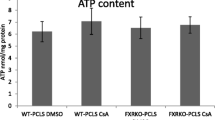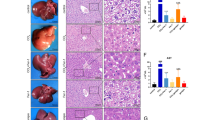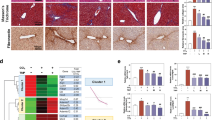Abstract
Pyrrolizidine alkaloids (PAs) are widely occurring phytotoxins which can induce severe liver damage in humans and other mammalian species by mechanisms that are not fully understood. Therefore, we investigated the development of PA hepatotoxicity in vivo, using an acutely toxic dose of the PA senecionine in mice, in combination with intravital two-photon microscopy, histology, clinical chemistry, and in vitro experiments with primary mouse hepatocytes and liver sinusoidal endothelial cells (LSECs). We observed pericentral LSEC necrosis together with elevated sinusoidal marker proteins in the serum of senecionine-treated mice and increased sinusoidal platelet aggregation in the damaged tissue regions. In vitro experiments showed no cytotoxicity to freshly isolated LSECs up to 500 µM senecionine. However, metabolic activation of senecionine by preincubation with primary mouse hepatocytes increased the cytotoxicity to cultivated LSECs with an EC50 of approximately 22 µM. The cytochrome P450 (CYP)-dependency of senecionine bioactivation was confirmed in CYP reductase-deficient mice where no PA-induced hepatotoxicity was observed. Therefore, toxic metabolites of senecionine are generated by hepatic CYPs, and may be partially released from hepatocytes leading to destruction of LSECs in the pericentral region of the liver lobules. Analysis of hepatic bile salt transport by intravital two-photon imaging revealed a delayed uptake of a fluorescent bile salt analogue from the hepatic sinusoids into hepatocytes and delayed elimination. This was accompanied by transcriptional deregulation of hepatic bile salt transporters like Abcb11 or Abcc1. In conclusion, senecionine destroys LSECs although the toxic metabolite is formed in a CYP-dependent manner in the adjacent pericentral hepatocytes.




Similar content being viewed by others
Abbreviations
- 3-MC:
-
3-Methylcholanthrene
- ALT:
-
Alanine transaminase
- AST:
-
Aspartate transaminase
- AU:
-
Arbitrary unit
- AUC:
-
Area under the curve
- BC:
-
Bile canaliculi
- BW:
-
Body weight
- LE:
-
Liver extract
- CLF:
-
Cholyl-lysyl-fluorescein
- CYP:
-
Cytochrome P450 monooxygenase(s)
- GFP:
-
Green fluorescent protein
- CV:
-
Central vein
- HE:
-
Hematoxylin-eosin staining
- KH buffer:
-
Krebs–Henseleit buffer
- LSEC:
-
Liver sinusoidal endothelial cells
- NPC:
-
Non-parenchymal cells
- PI:
-
Propidium iodide
- PA(s):
-
Pyrrolizidine alkaloid(s)
- PMH:
-
Primary mouse hepatocytes
- POR:
-
NADPH-cytochrome P450 reductase
- t1/2 :
-
Half-life
- t max :
-
Time to maximum
- TMRE:
-
Tetramethylrhodamine ethyl ester
- VOD:
-
Veno-occlusive disease
References
Baker DC, Pfister JA, Molyneux RJ, Kechele P (1991) Cynoglossum officinale toxicity in calves. J Comp Pathol 104(4):403–410
Bodi D, Ronczka S, Gottschalk C et al (2014) Determination of pyrrolizidine alkaloids in tea, herbal drugs and honey. Food Addit Contam Part A Chem Anal Control Expo Risk Assess 31(11):1886–1895. https://doi.org/10.1080/19440049.2014.964337
Chen Z, Huo JR (2010) Hepatic veno-occlusive disease associated with toxicity of pyrrolizidine alkaloids in herbal preparations. Neth J Med 68(6):252–260
Constien R, Forde A, Liliensiek B et al (2001) Characterization of a novel EGFP reporter mouse to monitor Cre recombination as demonstrated by a Tie2 Cre mouse line. Genesis 30(1):36–44
Copple BL, Rondelli CM, Maddox JF, Hoglen NC, Ganey PE, Roth RA (2004) Modes of cell death in rat liver after monocrotaline exposure. Toxicol Sci 77(1):172–182. https://doi.org/10.1093/toxsci/kfh011
Datta DV, Khuroo MS, Mattocks AR, Aikat BK, Chhuttani PN (1978) Herbal medicines and veno-occlusive disease in India. Postgrad Med J 54(634):511–515. https://doi.org/10.1136/pgmj.54.634.511
DeLeve LD, Shulman HM, McDonald GB (2002) Toxic injury to hepatic sinusoids: sinusoidal obstruction syndrome (veno-occlusive disease). Semin Liver Dis 22(1):27–42. https://doi.org/10.1055/s-2002-23204
DeLeve LD, Ito Y, Bethea NW, McCuskey MK, Wang X, McCuskey RS (2003a) Embolization by sinusoidal lining cells obstructs the microcirculation in rat sinusoidal obstruction syndrome. Am J Physiol Gastrointest Liver Physiol 284(6):G1045–G1052. https://doi.org/10.1152/ajpgi.00526.2002
Deleve LD, Wang X, Tsai J, Kanel G, Strasberg S, Tokes ZA (2003b) Sinusoidal obstruction syndrome (veno-occlusive disease) in the rat is prevented by matrix metalloproteinase inhibition. Gastroenterology 125(3):882–890
Denk W, Strickler J, Webb W (1990) Two-photon laser scanning fluorescence microscopy. Science 248(4951):73–76. https://doi.org/10.1126/science.2321027
Dusemund B, Nowak N, Sommerfeld C, Lindtner O, Schafer B, Lampen A (2018) Risk assessment of pyrrolizidine alkaloids in food of plant and animal origin. Food Chem Toxicol 115:63–72. https://doi.org/10.1016/j.fct.2018.03.005
Ebmeyer J, Behrend J, Lorenz M et al (2019a) Pyrrolizidine alkaloid-induced alterations of prostanoid synthesis in human endothelial cells. Chem Biol Interact 298:104–111. https://doi.org/10.1016/j.cbi.2018.11.007
Ebmeyer J, Braeuning A, Glatt H, These A, Hessel-Pras S, Lampen A (2019b) Human CYP3A4-mediated toxification of the pyrrolizidine alkaloid lasiocarpine. Food Chem Toxicol 130:79–88. https://doi.org/10.1016/j.fct.2019.05.019
Ebmeyer J, Franz L, Lim R et al (2019c) Sensitization of human liver cells toward fas-mediated apoptosis by the metabolically activated pyrrolizidine alkaloid lasiocarpine. Mol Nutr Food Res. https://doi.org/10.1002/mnfr.201801206
EFSA (2016) Dietary exposure assessment to pyrrolizidine alkaloids in the European population. EFSA J 14(8):50
Fox DW, Hart MC, Bergeson PS, Jarrett PB, Stillman AE, Huxtable RJ (1978) Pyrrolizidine (Senecio) intoxication mimicking Reye syndrome. J Pediatr 93(6):980–982. https://doi.org/10.1016/S0022-3476(78)81227-X
Fu PP, Xia Q, Lin G, Chou MW (2004) Pyrrolizidine alkaloids—genotoxicity, metabolism enzymes, metabolic activation, and mechanisms. Drug Metab Rev 36(1):1–55. https://doi.org/10.1081/DMR-120028426
Gao H, Li N, Wang JY, Zhang SC, Lin G (2012) Definitive diagnosis of hepatic sinusoidal obstruction syndrome induced by pyrrolizidine alkaloids. J Dig Dis 13(1):33–39. https://doi.org/10.1111/j.1751-2980.2011.00552.x
Gordon GJ, Coleman WB, Grisham JW (2000) Bax-mediated apoptosis in the livers of rats after partial hepatectomy in the retrorsine model of hepatocellular injury. Hepatology 32(2):312–320. https://doi.org/10.1053/jhep.2000.9144
Helmchen F, Denk W (2005) Deep tissue two-photon microscopy. Nat Methods 2(12):932–940. https://doi.org/10.1038/nmeth818
Helmy A (2006) Review article: updates in the pathogenesis and therapy of hepatic sinusoidal obstruction syndrome. Aliment Pharmacol Ther 23(1):11–25. https://doi.org/10.1111/j.1365-2036.2006.02742.x
Henderson CJ, McLaughlin LA, Osuna-Cabello M et al (2015) Application of a novel regulatable Cre recombinase system to define the role of liver and gut metabolism in drug oral bioavailability. Biochem J 465(3):479–488. https://doi.org/10.1042/bj20140582
Kakar F, Akbarian Z, Leslie T et al (2010) An outbreak of hepatic veno-occlusive disease in Western Afghanistan associated with exposure to wheat flour contaminated with pyrrolizidine alkaloids. J Toxicol 2010:313280. https://doi.org/10.1155/2010/313280
Koni PA, Joshi SK, Temann UA, Olson D, Burkly L, Flavell RA (2001) Conditional vascular cell adhesion molecule 1 deletion in mice: impaired lymphocyte migration to bone marrow. J Exp Med 193(6):741–754
Luckert C, Hessel S, Lenze D, Lampen A (2015) Disturbance of gene expression in primary human hepatocytes by hepatotoxic pyrrolizidine alkaloids: a whole genome transcriptome analysis. Toxicol In Vitro 29(7):1669–1682. https://doi.org/10.1016/j.tiv.2015.06.021
Mendel VE, Witt MR, Gitchell BS et al (1988) Pyrrolizidine alkaloid-induced liver disease in horses: an early diagnosis. Am J Vet Res 49(4):572–578
Merz KH, Schrenk D (2016) Interim relative potency factors for the toxicological risk assessment of pyrrolizidine alkaloids in food and herbal medicines. Toxicol Lett 263:44–57. https://doi.org/10.1016/j.toxlet.2016.05.002
Mohabbat O, Younos MS, Merzad AA, Srivastava RN, Sediq GG, Aram GN (1976) An outbreak of hepatic veno-occlusive disease in north-western Afghanistan. Lancet (London, England) 2(7980):269–271
Mulder PPJ, Sánchez PL, These A, Preiss-Weigert A, Castellari M (2015) Occurrence of pyrrolizidine alkaloids in food. EFSA Support Publ. 12(8):859E. https://doi.org/10.2903/sp.efsa.2015.en-859
Muzumdar MD, Tasic B, Miyamichi K, Li L, Luo L (2007) A global double-fluorescent Cre reporter mouse. Genesis 45(9):593–605. https://doi.org/10.1002/dvg.20335
Park BK, Kitteringham NR, Maggs JL, Pirmohamed M, Williams DP (2005) The role of metabolic activation in drug-induced hepatotoxicity. Annu Rev Pharmacol Toxicol 45:177–202. https://doi.org/10.1146/annurev.pharmtox.45.120403.100058
Pei QL, Kobayashi Y, Tanaka Y et al (2002) Increased expression of multidrug resistance-associated protein 1 (mrp1) in hepatocyte basolateral membrane and renal tubular epithelia after bile duct ligation in rats. Hepatol Res 22(1):58–64
Reif R, Karlsson J, Gunther G et al (2015) Bile canalicular dynamics in hepatocyte sandwich cultures. Arch Toxicol 89(10):1861–1870. https://doi.org/10.1007/s00204-015-1575-9
Reif R, Ghallab A, Beattie L et al (2017) In vivo imaging of systemic transport and elimination of xenobiotics and endogenous molecules in mice. Arch Toxicol 91(3):1335–1352. https://doi.org/10.1007/s00204-016-1906-5
Ruan J, Yang M, Fu P, Ye Y, Lin G (2014) Metabolic activation of pyrrolizidine alkaloids: insights into the structural and enzymatic basis. Chem Res Toxicol 27(6):1030–1039. https://doi.org/10.1021/tx500071q
Steenkamp V, Stewart MJ, van der Merwe S, Zuckerman M, Crowther NJ (2001) The effect of Senecio latifolius a plant used as a South African traditional medicine, on a human hepatoma cell line. J Ethnopharmacol 78(1):51–58. https://doi.org/10.1016/S0378-8741(01)00321-X
Stegelmeier BL, Gardner DR, James LF, Molyneux RJ (1996) Pyrrole detection and the pathologic progression of Cynoglossum officinale (houndstongue) poisoning in horses. J Vet Diagn Invest 8(1):81–90. https://doi.org/10.1177/104063879600800113
Stegelmeier BL, Edgar JA, Colegate SM et al (1999) Pyrrolizidine alkaloid plants, metabolism and toxicity. J NatToxins 8(1):95–116
Stillman AS, Huxtable R, Consroe P, Kohnen P, Smith S (1977) Hepatic veno-occlusive disease due to pyrrolizidine (Senecio) poisoning in Arizona. Gastroenterology 73(2):349–352
Tandon HD, Tandon BN, Mattocks AR (1978) An epidemic of veno-occlusive disease of the liver in Afghanistan Pathologic features. Am J Gastroenterol 70(6):607–613
Waizenegger J, Braeuning A, Templin M, Lampen A, Hessel-Pras S (2018) Structure-dependent induction of apoptosis by hepatotoxic pyrrolizidine alkaloids in the human hepatoma cell line HepaRG: single versus repeated exposure. Food Chem Toxicol 114:215–226. https://doi.org/10.1016/j.fct.2018.02.036
Wang X, Kanel GC, DeLeve LD (2000) Support of sinusoidal endothelial cell glutathione prevents hepatic veno-occlusive disease in the rat. Hepatology 31(2):428–434. https://doi.org/10.1002/hep.510310224
WHO (1988) WHO IPCS International Programme on Chemical Safety: Pyrrolizidine alkaloids Environmental Health Criteria, vol 80. World Health Organization, Geneva
Xiong A, Yang F, Fang L et al (2014) Metabolomic and genomic evidence for compromised bile acid homeostasis by senecionine, a hepatotoxic pyrrolizidine alkaloid. Chem Res Toxicol 27(5):775–786. https://doi.org/10.1021/tx400451q
Yang M, Ruan J, Fu PP, Lin G (2016) Cytotoxicity of pyrrolizidine alkaloid in human hepatic parenchymal and sinusoidal endothelial cells: firm evidence for the reactive metabolites mediated pyrrolizidine alkaloid-induced hepatotoxicity. Chem Biol Interact 243:119–126. https://doi.org/10.1016/j.cbi.2015.09.011
Acknowledgements
This work was supported by the German Research Foundation (Grant Number LA1177/12-1), by the German Federal Institute for Risk Assessment (Grant Numbers 1322-591 and 1322-624) and the BMBF funded project LiSyM. ERL mice were generated under Cancer Research UK Programme Grant C4639/A10822 awarded to Professor C.R. Wolf. Additionally, we thank Ms. Brigitte Begher-Tibbe (Leibniz Research Center for Working Environment and Human Factors, Technical University Dortmund, Germany) for Immunostaining and for 3 D reconstructions. Special thanks to Ms. Gisela H. Degen for scientific discussion and proof reading of the manuscript.
Funding
This work was supported by the German Research Foundation (Grant Number LA1177/12-1), by the German Federal Institute for Risk Assessment (Grant Numbers 1322-591 and 1322-624) and the BMBF Funded project LiSyM. ERL mice were generated under Cancer Research UK Programme Grant C4639/A10822 awarded to Professor C.R. Wolf.
Author information
Authors and Affiliations
Corresponding author
Ethics declarations
Conflict of interest
The authors declare that they have no conflict of interest.
Additional information
Publisher's Note
Springer Nature remains neutral with regard to jurisdictional claims in published maps and institutional affiliations.
Electronic supplementary material
Below is the link to the electronic supplementary material.
Rights and permissions
About this article
Cite this article
Hessel-Pras, S., Braeuning, A., Guenther, G. et al. The pyrrolizidine alkaloid senecionine induces CYP-dependent destruction of sinusoidal endothelial cells and cholestasis in mice. Arch Toxicol 94, 219–229 (2020). https://doi.org/10.1007/s00204-019-02582-8
Received:
Accepted:
Published:
Issue Date:
DOI: https://doi.org/10.1007/s00204-019-02582-8




